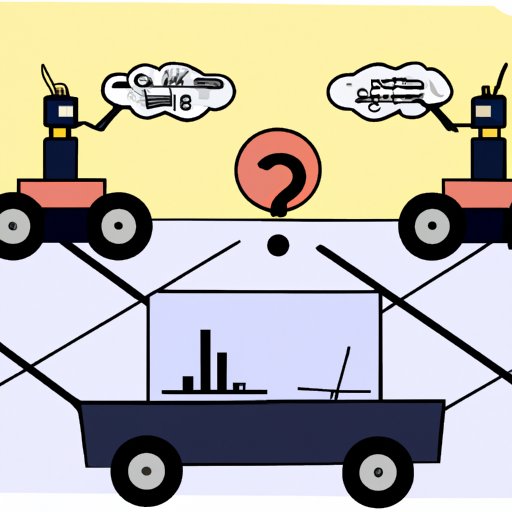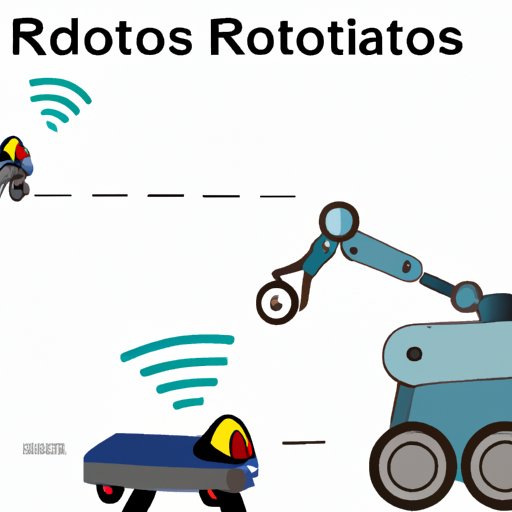Introduction
Autonomous mobile robots are increasingly being developed for a wide range of applications. From self-driving cars to delivery robots, these advanced machines are revolutionizing the way we interact with our environment. But what exactly are autonomous mobile robots and how do they work? This article explores the components, artificial intelligence, navigation, decision-making processes, benefits, and challenges of autonomous mobile robots.

Exploring the Components of Autonomous Mobile Robots
Autonomous mobile robots are composed of several different components that enable them to sense and interact with their environment. These components include sensors, actuators, computers and controllers.
Sensors
Sensors are used to collect data about the environment. They come in a variety of shapes and sizes and can detect things such as temperature, pressure, sound, light, and motion. For example, some sensors are used to detect obstacles or changes in the terrain. This allows the robot to navigate its environment safely.
Actuators
Actuators are used to translate the data collected by the sensors into physical actions. They come in a variety of shapes and sizes, and can move the robot’s body, arms, wheels, or other parts. Actuators also allow the robot to manipulate objects in its environment.
Computers and Controllers
Computers and controllers are used to process the data collected by the sensors and to control the actuators. Computers are used to store and process data, while controllers are used to interpret the data and decide how the robot should respond. Together, these components give the robot the ability to sense and interact with its environment.
Understanding the Role of Artificial Intelligence in Autonomous Mobile Robots
Artificial intelligence (AI) is playing an increasingly important role in autonomous mobile robots. AI techniques such as machine learning, natural language processing, and computer vision allow robots to make decisions, interpret data, and interact with their environment. Here, we explore a few of these AI techniques.
Machine Learning
Machine learning is a form of AI that enables robots to learn from experience. Through trial and error, the robot can learn to recognize patterns in data and identify objects in its environment. This allows the robot to make informed decisions and adapt to changing conditions.
Natural Language Processing
Natural language processing (NLP) is a form of AI that enables robots to understand and respond to human speech. By using NLP, robots can interact with humans in a more natural way, allowing for better communication and collaboration.
Computer Vision
Computer vision is a form of AI that enables robots to “see” their environment. Using cameras and image recognition algorithms, robots can identify objects, track movement, and detect obstacles. This allows the robot to navigate its environment and interact with objects.
Examining How Autonomous Mobile Robots Navigate and Interact with Their Environment
In order to navigate and interact with their environment, autonomous mobile robots rely on several key technologies. Path planning, obstacle avoidance, and localization are all essential components of autonomous navigation.
Path Planning
Path planning is a technique used by robots to plan a safe and efficient route through their environment. By analyzing data from sensors, the robot can determine the best route to its destination and avoid obstacles along the way.
Obstacle Avoidance
Obstacle avoidance is a technique used by robots to avoid collisions with objects in their environment. By using sensors to detect obstacles, the robot can adjust its course to avoid them. This helps the robot to safely navigate its environment.
Localization
Localization is a technique used by robots to determine their location in their environment. By using sensors and GPS, the robot can identify its exact position and orient itself accordingly.

Investigating How Autonomous Mobile Robots Make Decisions
Autonomous mobile robots must be able to make decisions in order to navigate their environment and interact with objects. There are two main approaches to decision-making: rule-based decision making and reinforcement learning.
Rule-Based Decision Making
Rule-based decision making is a technique used by robots to make decisions based on pre-defined rules. By using if-then statements, the robot can determine how to respond to different situations. This approach is useful for simple tasks but can be limited.
Reinforcement Learning
Reinforcement learning is a form of AI that enables robots to learn from experience. By giving the robot rewards or punishments, it can learn to make better decisions over time. This approach is more flexible than rule-based decision making but requires more computing power.

Analyzing the Benefits of Autonomous Mobile Robots
Autonomous mobile robots offer many benefits, including increased efficiency, reduced costs, and improved safety. Here, we explore some of the advantages of these advanced machines.
Increased Efficiency
Autonomous mobile robots can perform tasks more quickly and accurately than humans, leading to increased efficiency. According to a study by the International Federation of Robotics, robots can increase productivity by up to 30%.
Reduced Costs
Autonomous mobile robots can reduce labor costs by replacing humans in certain tasks. In addition, robots can reduce energy costs by operating more efficiently than humans.
Increased Safety
Autonomous mobile robots can improve safety by reducing the risk of accidents. By using sensors and AI algorithms, robots can detect and avoid obstacles, reducing the likelihood of collisions.
Evaluating the Challenges of Implementing Autonomous Mobile Robots
Although autonomous mobile robots offer many benefits, there are also several challenges associated with their implementation. Technical limitations, regulatory challenges, and cost considerations are all potential issues.
Technical Limitations
Autonomous mobile robots are still limited by their technical capabilities. Sensors may not be able to accurately detect obstacles or changes in terrain, and AI algorithms may not be able to make accurate decisions in complex environments.
Regulatory Challenges
There are also regulatory challenges associated with the deployment of autonomous mobile robots. Governments around the world are still trying to figure out how to regulate these devices, and this can create uncertainty for companies looking to deploy them.
Cost Considerations
Finally, cost is a major factor when it comes to implementing autonomous mobile robots. The cost of sensors, computers, and other components can add up quickly, and this can be a major barrier for companies looking to deploy them.
Conclusion
Autonomous mobile robots are increasingly being developed for a wide range of applications. They are composed of several components, including sensors, actuators, computers, and controllers. AI techniques such as machine learning, natural language processing, and computer vision allow robots to make decisions, interpret data, and interact with their environment. Path planning, obstacle avoidance, and localization allow robots to navigate their environment. Autonomous mobile robots offer many benefits, including increased efficiency, reduced costs, and improved safety. However, there are still several challenges associated with their implementation, including technical limitations, regulatory challenges, and cost considerations.
In conclusion, autonomous mobile robots are becoming increasingly sophisticated, and they offer many potential benefits. However, there are still several challenges associated with their implementation, and further research is needed to address these issues. With the right technology and regulations in place, autonomous mobile robots could revolutionize the way we interact with our environment.
(Note: Is this article not meeting your expectations? Do you have knowledge or insights to share? Unlock new opportunities and expand your reach by joining our authors team. Click Registration to join us and share your expertise with our readers.)
